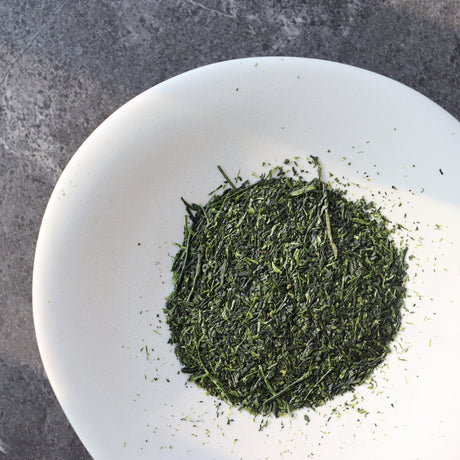Under the broadest definition of sencha as a steamed, rolled green tea, gyokuro would be considered the pinnacle of flavor. The catechins (a kind of antioxidant) that create bitter flavors in tea are prevented from forming due to the shading of the plant while the leaves are growing. Instead, the plant preserves a high level of L-theanine amino acid content resulting in an increase in umami flavors. The shading also increase chlorophyll generating beautiful deep green colors in the leaves.
Shading: There are two variables in shading techniques used for all shaded teas including kabusecha, gyokuro, tencha and matcha) - setup and material.
More expensive shaded teas are created using a canopy setup. Scaffolding is built over the tea field to ensure that the shading material rests above the tea plants. This allows the plants to grow freely, and allows for space when picking by hand. The less time consuming method is to lay the shading material directly onto the plants. The method is suitable for machine harvesting; the leaves are constricted under the weight of the material, and may become damaged if wind causes the shading to flap against the leaves.
In terms of material, farmers may use either some kind of plastic sheet which is cheaper and will last longer. Or for more premium teas, various types of straw or reed material may be used allowing for layering (and therefore a gradual adjustment of sunlight that reach the leaves). Using natural material is also much more time consuming increasing production cost.
Harvesting: The easiest method to harvest teas is by machine. Smaller farms may use a single or 2-person cutting machine that blows the cut leaves into a bag, and larger farms on flat areas may use a tractor-style harvesting machine that can harvest 1-3 rows of hedges at a time depending on their size. The hedges are pre-shaped before leaves come out by an initial cutting, creating a base from which new leaves appear. This base allows the farmer to minimize inclusion of older leaf/stem plant material in the harvest.
Handpicking the tea leaves is common to produce the most premium levels of tea...and usually only a very small amount is produced (even the largest farms will produce a few dozen kilograms at most). Picking is often done by volunteers, friends/family of the farmers, and occasionally by part-time workers (though not a sustainable method in Japan where minimum wages are high).
A compromise between machine harvesting and handpicking is the use of sheers / scissors with a bag attached to catch leaves that are cut. This allows the harvester to pick more leaves at once but be more selective than a larger harvesting machine.
Processing: Gyokuro is processed like sencha with the many possible variables that can be adjusted, the most important being the steaming time. A light (short) steaming time allows the farmer to maintain the shape of the leaf, this results in long perfectly shaped needles when rolled. The resulting tea is produces a light, translucent yellowish color. Meanwhile a longer steaming time will produce a darker green color, but it will be more opaque due to the more broken leaf.














